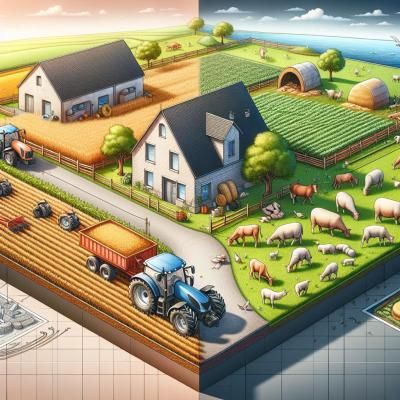Understanding the Importance of Protecting Your Agricultural Investment
Your farm isn't just a business; it's the backbone of your livelihood. The significance of securing your hard-earned investment with farm insurance cannot be overstated. Australian agriculture is no stranger to the ravages of Mother Nature—from drought to flood, fire to cyclone. Each weather event holds the potential to endanger not just your crops, but your livestock, equipment, and even your farm's infrastructure. Comprehensive farm insurance offers a safety net, ensuring that when the unexpected occurs, you're prepared to weather the storm and bounce back with resilience.
Overview of What Farm Insurance Typically Covers
Farm insurance is a specialized product designed to meet the specific needs of the farming community. It often encompasses a variety of policies to protect different aspects of your operation. Coverage can range from crop insurance, which safeguards against the loss of your primary income source, to livestock insurance, which covers the well-being of your animals. Property insurance for farm buildings, machinery insurance for equipment, and liability insurance for legal protection are also integral components of a robust farm insurance plan.
The Unique Nature of Farming and Why Standard Insurance Might Not Suffice
The intricate nature of farming means that standard business insurance policies don't always fit the bill. Farming requires a tailored approach to risk management—one that understands the difference between a tractor and a thrasher, and how the loss of either can impact your harvest. Standard insurance policies may miss these nuances, leaving you without the necessary protection when it's needed most. A specialized farm insurance policy is designed with the unique risks of the agricultural sector in mind, giving you peace of mind and the freedom to focus on growing your business.
The Essentials of Tractor Insurance
Within the agricultural arsenal, tractors stand as a crucial cornerstone, significantly contributing to the efficacy and efficiency of farm operations. The significance of these mechanical workhorses cannot be understated, as they represent a substantial capital investment and are pivotal to both day-to-day activities and long-term success of the farm.
Why Tractors Represent a Significant Investment and the Risks They Face
Tractors are more than just vehicles; they are versatile engines that drive the modern farm. These complex machines face a multitude of risks ranging from accidental damage during daily operations to theft and even natural disasters. Such events can lead to costly downtime or, worse, the need for an expensive replacement. In Australia's arduous conditions, the question isn't if a tractor can fall prey to such risks, but when.
The Types of Coverage Available for Tractors
Understanding the imperative need for adequate protection, various forms of tractor insurance are available. There's coverage for the basics, like accidental damage or theft, but options extend to more specialized forms such as third-party liability if your tractor accidentally damages another's property. Each policy comes with a set of terms and coverage limits, and it's important to comprehend these details to ensure your tractor is protected against the most probable risks.
Ensuring that your insurance policy matches the value and use of your tractor is paramount. Whether it's a high-horsepower rig for large-scale farming or a smaller utility tractor for varied tasks, insurers offer plans that align with the nature and intensity of their use.
Additional Coverage Options to Consider
While the basics of tractor insurance are essential, there are additional coverages that can provide further peace of mind. Equipment breakdown coverage is one such option, safeguarding against losses from mechanical or electrical failures—a common occurrence that can disrupt farm operations. Rental reimbursement is another supplemental coverage, which can be a lifesaver by covering the cost of a replacement tractor, ensuring continuity of work during repairs or replacement of your insured vehicle. These additional options can tailor your tractor insurance to the unique contours of your farming business.
Protecting Your Livestock
Livestock is not just a valuable asset to a farm; it represents the lifeblood of many agricultural operations. Just like any crucial asset, it requires protection. Livestock insurance plays a vital role in the financial stability of a farm by providing compensation in the event of animal loss. This safety net ensures the farmer can continue operations despite potentially devastating setbacks.
The Types of Risks Your Livestock Could Be Exposed To
Livestock are vulnerable to a wide range of risks, from natural threats like extreme weather conditions and diseases to man-made issues such as accidents or theft. Australian farms, with their vast and diverse environments, expose animals to unique hazards that can vary significantly from one region to another. This makes assessing the risk profile of your livestock a critical step in setting up the right insurance cover.
Mortality Insurance vs. Specified Perils Coverage
When it comes to safeguarding your livestock, there are generally two types of insurance: mortality insurance and specified perils coverage. Mortality insurance offers compensation for the death of animals due to a broad range of causes, including accidents and illness. Specified perils coverage, by contrast, is limited to losses resulting from specific named events, such as fires, floods, or predators attacks. Understanding the difference between these policies is key to choosing the appropriate protection for your herd.
Customizing Your Livestock Insurance Based On Your Farm's Requirements
Given the variety of livestock types and farming practices, a one-size-fits-all policy is inadequate. Insurance providers often allow for customization of livestock policies to fit specific needs. You may be a breeder of high-value pedigree stock, run a dairy farm, or rear livestock for meat production—each type of operation has unique risks and insurance requirements. It is crucial to cover not just the value of the livestock but also factor in potential lost income. Custom policies will also consider variables like herd size, the rarity of the breed, and even genetic value. Careful assessment of your farm's particular needs will help tailor a livestock insurance policy that provides comprehensive protection without unnecessary costs.
Coverage for Your Crops
Understanding the Necessity of Crop Insurance
Crops are the cornerstone of any farming operation, representing a substantial portion of a farm's value. Crop insurance is, therefore, a vital component of your farm's risk management strategy. Unpredictable weather patterns, diseases, and pest infestations can all pose significant threats to your harvest. Crop insurance provides a financial safety net that can help ensure the survival of your farm through catastrophic events, allowing you to plant again next season with confidence.
The Difference Between Multi-Peril and Named-Peril Crop Insurance Policies
When it comes to crop insurance, there are two primary types of policies: multi-peril and named-peril. Multi-peril crop insurance (MPCI) offers comprehensive protection, covering a range of risks that could affect crop yield and quality. From drought and excessive rainfall to insect infestations and disease, MPCI is designed to cover the unpredictable nature of farming. Named-peril insurance, however, is more specific, providing coverage for a list of defined risks. This type of policy may be more suitable for farms with particular concerns or those located in regions prone to specific types of weather events. The selection between multi-peril and named-peril policies depends on your farm's location, crop types, and your willingness to manage risk.
Government Programs and Private Options for Crop Insurance
In Australia, farmers have access to both government programs and private insurance options to protect their crops. Government programs may offer certain subsidies or support for crop insurance premiums, making it more accessible for farmers to get the protection they need. Private insurance companies, on the other hand, often provide more tailored options that can be customized to the unique needs of your farm. It's important to explore all available avenues, understanding the terms and benefits of each program or policy. Comparing government and private options will help you secure the most appropriate and cost-effective crop insurance for your agricultural enterprise.
Additional Coverage to Consider
Embarking on the quest for comprehensive farm insurance, it's crucial to go beyond the fields and cattle. Your farmland is more than just crops and livestock; it encompasses essential structures and faces multifaceted risks. Delving into additional coverage is not just about safeguarding your primary assets but also about securing the complete functionality and sustainability of your farming business.
Property Insurance for Farm Buildings and Contents
Your farm’s infrastructure, including barns, sheds, and processing facilities, forms the backbone of your operations. Property insurance for farm buildings and contents goes beyond basic structural damage, covering the tools, machinery, and even the feed stored inside. This level of coverage ensures that in the case of incidents like fire, storm, or theft, your financial stability isn’t upturned. Assessing the value of these assets and including them in your policy will hedge against unexpected blows to your operational capability.
Liability Insurance for Farm Operations
Farming activities, though routine to the seasoned grower, carry inherent risks to workers, visitors, and consumers alike. Liability insurance for farm operations is a safeguard against claims resulting from personal injuries or property damage caused by your farming activities. It acts as a critical buffer, preserving your finances and reputation in the face of accidents or oversights that could otherwise lead to costly legal battles.
Business Interruption Insurance for Unforeseen Circumstances
When unexpected events disrupt your well-laid plans and halt your farm's operations, the repercussions can ricochet through your revenue stream. Business interruption insurance is designed to mitigate this risk, providing compensation for lost income during periods where your farm is out of action. Whether due to a natural disaster or a critical machinery breakdown, this coverage supports your business's endurance through trying times.
Environmental and Pollution Coverage
The stewardship of land and resources is a fundamental part of modern farming ethics and operational requirements. Environmental and pollution insurance coverage is increasingly critical in a world where ecological responsibility is paralleled with liability concerns. This insurance can cover the costs of clean-up, regulatory fines, or legal defense in case your farm operations inadvertently lead to environmental damage—reinforcing your farm's sustainability against both ecological and financial fallouts.
Understanding Premiums and Discounts
Your farm insurance premium is essentially the price you pay for the peace of mind that comes with knowing your livelihood is protected. The calculation of this premium is sophisticated, influenced by a multitude of factors such as the type and number of policies you hold, the location and size of your farm, the value of your assets, and your claims history. Insurers analyze these elements to assess the level of risk in covering your farm and to determine a fair premium that reflects this risk.
How Insurance Companies Determine Your Farm Insurance Premiums
Insurers begin by evaluating the specifics of your farming operations, including the types of crops and livestock you raise, the machinery you operate, and even the weather patterns in your region. Each of these factors can significantly shift the risk profile of your farm. A farmer in a drought-prone area, for instance, might face higher premiums for crop insurance than one in a region with more consistent rainfall. Your insurance track record also plays a role; a history of frequent claims can signal higher risk, resulting in increased premium costs.
Tips for Minimizing Premiums While Maintaining Necessary Coverage
While some elements influencing premiums are beyond your control, there are actionable steps you can take to manage costs. Increasing your deductibles — the amount you pay out-of-pocket before insurance kicks in — can lower your premiums, but it's crucial to ensure you can afford these deductibles if needed. Investing in preventive measures, such as improved infrastructure to withstand adverse weather, can also reduce the likelihood of claims and lead to lower premiums over time. Moreover, maintaining accurate, up-to-date records of all your assets can ensure you're not over-insured nor under-insured but just rightly covered.
Available Discounts and How to Qualify for Them
Insurance companies often offer discounts to incentivize risk-lowering behavior among their policyholders. You might qualify for these discounts by bundling multiple policies with the same provider or by being a member of certain agricultural associations. Demonstrating a commitment to safe farming practices and having a solid risk management plan in place can also sway insurers to offer you reduced rates. It's worthwhile to actively inquire with your insurance provider about all potential discounts, as these savings can make a significant difference in your annual insurance expenses.
Choosing the Right Insurance Provider
Selecting the ideal insurance provider is a pivotal decision for safeguarding your farm. The right insurer offers not only financial stability and trustworthy coverage but also an understanding of the agricultural sector's unique challenges. It's about finding a partner who appreciates the intricacies of farming lifestyle and offers tailored solutions that resonate with your specific needs.
What to Look for in a Farm Insurance Company
A reputable farm insurance company should have a solid track record of financial strength and the ability to pay out claims promptly. Look beyond the basic policy provisions; search for a provider with extensive experience in agricultural insurance, one that provides comprehensive coverage options and risk assessment services. Exceptional customer support, especially in times of need, should also be high on your checklist when deliberating between potential insurers.
Transparency in policy details and pricing structure is another facet to consider. Your provider should help you understand the nuances of your insurance contract without any hidden costs or convoluted jargon. Clear communication is key—after all, an informed decision is a sound decision.
The Benefits of Working with an Agent Who Specializes in Agricultural Insurance
An agent with expertise in agricultural insurance can be an invaluable asset. They not only understand the language of farming but can also educate you on the specific risks your farm faces. These agents can customize insurance solutions meticulously, reflecting the distinctive nature of your agricultural pursuits. Instead of navigating the complex terrain of farm insurance alone, benefit from having an informed guide at your side—one who can advocate on your behalf.
Comparing Quotes and Policies to Find the Best Fit for Your Farm
Comparing quotes from multiple insurance providers is crucial. However, the process isn't about finding the cheapest option; it's about locating the best value—coverage that provides for your farm's needs at a reasonable price. Scrutinize the details of each quote, and match them with the demands of your operation. Pay attention to coverage limits, deductibles, and exclusions, as these will significantly impact the efficacy of your policy in the event of a claim.
Don't hesitate to ask questions. If certain aspects of a policy are unclear, request clarification. Remember, it's important that you fully comprehend what is and isn't covered. It's through due diligence and in-depth analysis that you'll arrive at the insurance solution most suited to your farm—the one that stands as a bastion against uncertainties and supports the continuity of your agricultural legacy.
Proactive Risk Management on the Farm
In addition to securing comprehensive insurance coverage, proactive risk management is quintessential in minimizing the potential for costly insurance claims. Rather than solely relying on insurance to bail you out after a mishap, taking steps to prevent incidents can protect both your farm's profitability and safety record. Proactive measures not only safeguard your assets but also contribute to creating a culture of safety and responsibility on your farm.
Best Practices for Reducing the Likelihood of Insurance Claims
Adopting best practices for risk management is one of the most effective ways to reduce the chances of insurance claims. This encompasses a range of strategies, from the education and training of staff to the application of technology for better monitoring of farm operations. Regular safety meetings can keep your team aware of potential hazards, while investment in quality equipment can prevent malfunctions that may otherwise lead to costly claims.
Additionally, staying abreast of the latest advancements in agricultural methods and integrating them into your own practices can significantly mitigate risks. Precision farming techniques, for example, can improve the resilience of your crops to weather extremes and pest infestations, thereby reducing the need for insurance claims related to yield loss.
Implementing Safety Measures to Protect Your Assets and Workers
The safety of your workers and the security of your assets should be a top priority. Implementing comprehensive safety measures can prevent accidents that lead to both human injury and damage to property. These measures might include proper signage around potential dangers, implementing safe work procedures, proper storage of chemicals, and ensuring that protective gear is worn at all times when necessary.
Investing in security systems to protect against theft and vandalism is also prudent. Secure fencing, surveillance equipment, and alarms can deter criminal activity. These measures not only protect your assets but can also lead to lower insurance premiums as they decrease the risk profile of your farm.
Regular Maintenance Schedules to Keep Equipment and Buildings in Top Shape
Maintaining your farm's infrastructure is crucial in preventing interruptions in farm operations. Regular maintenance schedules for your buildings and equipment can preclude many problems that would otherwise result in downtime and loss of income. Routine checks can identify issues before they become severe, ensuring that your facilities and machinery stay in optimal condition, extend their useful life, and avoid possible claims resulting from equipment breakdowns.
Creating and adhering to a thorough maintenance plan can streamline these checks and repairs, leading to more efficient farming practices. By actively managing these aspects of your farm, you not only decrease the potential for accidents and losses but also position your farm for greater productivity and success in the long term.
Conclusion: Securing Your Farm's Future
In the intricate dance with nature that is farming, insurance stands as a steadfast partner, ensuring that each unexpected sway or turn does not lead to a fall. Throughout this article, we've underscored the multifaceted nature of farm insurance, highlighting its vital role in protecting your agricultural endeavors from the unpredictable elements and challenges inherent to the profession.
Summarizing the Importance of Tailored Farm Insurance
Custom-tailored farm insurance is not a luxury; it's a fundamental necessity for every farmer seeking to safeguard their livelihood. Acknowledging the diverse threats that loom—from volatile weather to unforeseen accidents—it's clear that a one-size-fits-all approach to insurance will not suffice. As each farm's needs are as unique as the crops it yields, so too should be the approach to coverage. Holistic, custom-tailored policies are the linchpin for not just survival but the thriving of farms in the face of adversity.
Final Tips on Managing a Farm with Peace of Mind Through Comprehensive Coverage
To manage your farm with the peace of mind that comes with knowing you're well-covered, it's essential to engage in a continuous dialogue with your insurance provider, staying abreast of the latest offerings and ensuring your coverage evolves alongside your farm's growth. Keeping a keen eye on risk management practices will not only potentially lower your premiums, but it will also fortify your farm's resilience against potential threats.
Nurturing a proactive mindset, where regular assessments of your farm's vulnerability to risks are standard practice, is indispensable. Fortifying your farm against possible threats before they arise, can help you ensure the continuity of your operations regardless of what Mother Nature has in store.
Review Your Current Policies and Consider Updates as Necessary
As we draw the curtains on this discussion, I encourage you, the stewards of the land, to take the time to review your current insurance policies meticulously. Evaluate them in light of the unique characteristics of your farm, the changes in climate, and developments in agriculture technology. In these times of change, being proactive about your coverage could mean the difference between a bountiful season and a fallow year. Regularly consult with insurance experts, stay informed about governmental support programs, and above all, ensure that your insurance coverage is as resilient and adaptable as the farm it's designed to protect.
In conclusion, let farm insurance be the pillar that supports your agricultural journey into the future. With thoughtful planning and comprehensive coverage tailored to your specific needs, stride forward with confidence, knowing that your farm is prepared to face the challenges and triumphs that lie ahead.
Last updated: Wednesday 17th January, 2024









